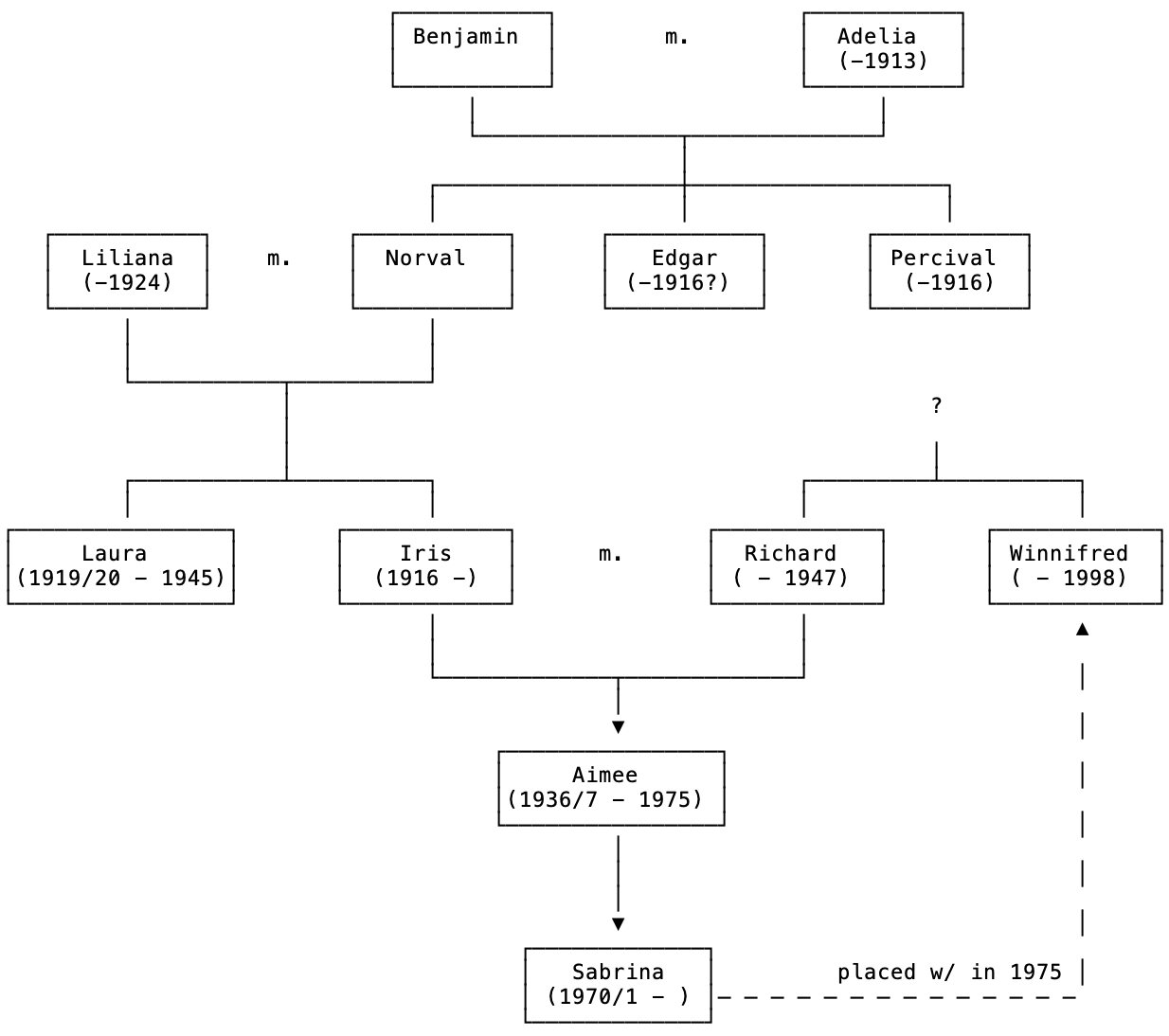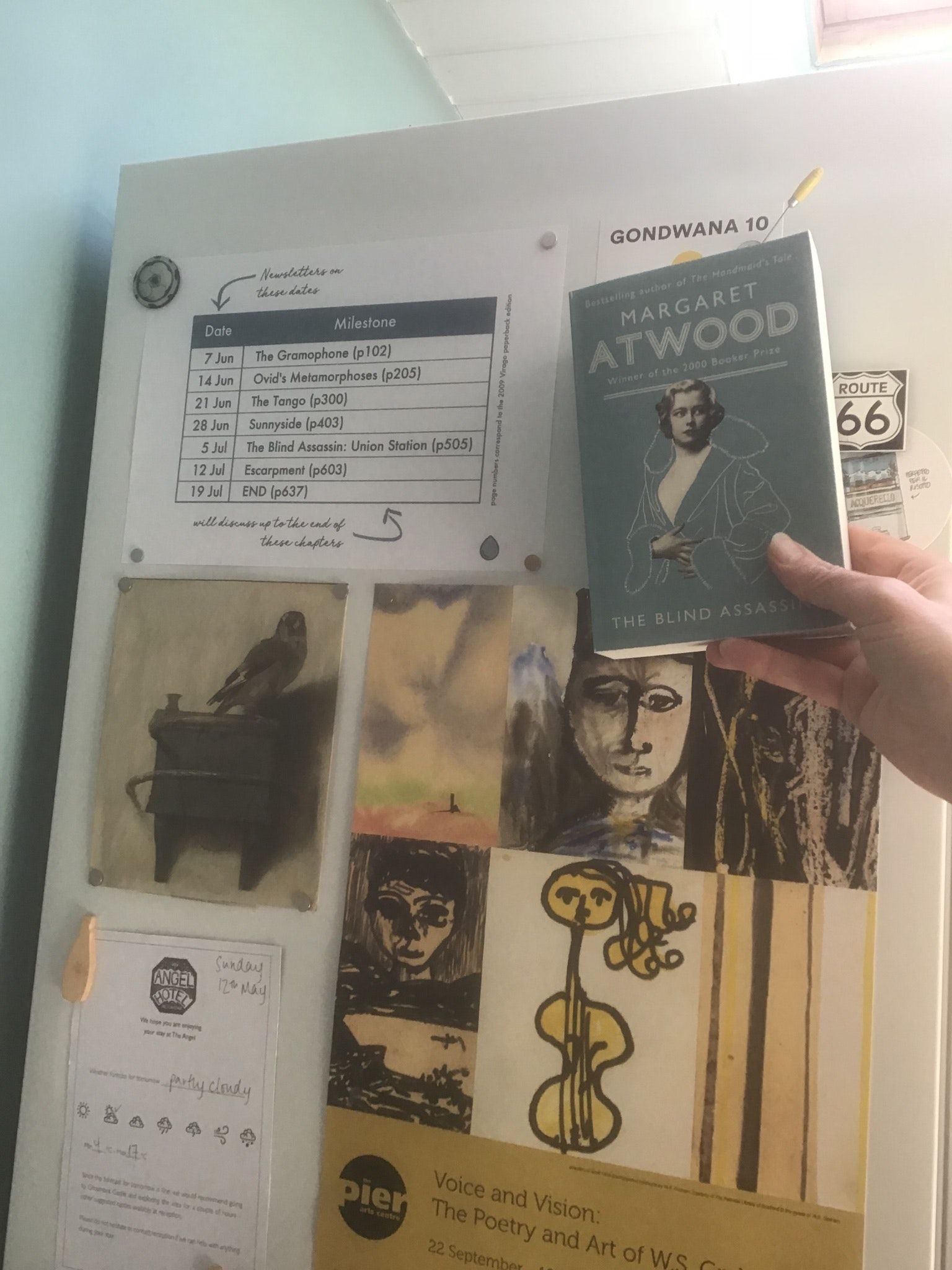Sipped Ink vol 6 issue 1
The Blind Assassin pp1-102
Hello friends. Did you enjoy the first week of reading? I hope you’re not feeling entirely weighed down by genealogies and the various layers of text we’ve been presented with — but if so, perhaps we can figure this out together.
First of all, a little context. As some of you know, I started Sipped Ink in 2014 because I was having trouble making it through David Foster Wallace’s Infinite Jest (1996) without moral support. Over the years a growing group has read a couple of novels I would not have tackled if it wasn’t for the read-along format (Roberto Bolaño’s 2666 (2009) chief amongst them), as well as novels I would probably have read either way: I think of Hanya Yanagihara’s wonderful A Little Life (2015) in this category. I loved that book so much, and the experience of reading it with a group enriched it for me in ways I wouldn’t have been able to predict. I’m hoping that this year’s read-along will prove to be similar in some respects.
My own history with the work of Margaret Atwood bears mentioning in passing. When studying for my BA in English & American Literature (lo, now all those many years ago) I took a class dedicated entirely to Atwood’s work. It was taught by the incomparable Prof Coral Ann Howells, and I was one of thirteen students who worked our way through about a half-dozen novels, alongside short stories, poetry, and non-fiction. I found it enormously enjoyable — Atwood is a writer who (famously) makes challenging, complicated themes and ideas central to her work, whilst her prose style makes them accessible and human. The discussions that arose from reading her work formed the basis of some of the most engaging seminars I was part of, with students regularly connecting with the work on an emotional as well as intellectual level. Here’s hoping we can get something similar out of our time together reading The Blind Assassin. One of the impetuses for my selecting the novel is that it remains a notable gap in my Atwood reading, so thank you once again for providing the opportunity to get around to reading it.
Let’s talk about some context around the novel itself. You may know that it won the Booker Prize in 2000. Atwood was certainly no stranger to the Booker shortlist by this time, having previously been shortlisted for The Handmaid’s Tale (in 1986); Cat’s Eye (in 1989); and Alias Grace (in 1996), but the win in 2000 was her first – a feat she would repeat in 2019 with The Testaments, joining the illustrious list of people who have won the award twice. (Fun fact: alongside Iris Murdoch, Atwood is the most frequently shortlisted writer for the Booker with six nominations.) (Not fun fact: researching this I have only just realised that Ali Smith has never won the Booker prize, which made my brain do a backflip.) By 2000 Atwood had also won more than a dozen other awards — including the Arthur C Clarke award and a Guggenheim fellowship — and had been awarded the Order of Canada, and as many as 14 honorary degrees from universities across Canada, the US, and the UK.
All of which is to underscore just what an accomplished novelist (and poet, essayist, editor, activist, librettist etc.) Atwood was when she wrote The Blind Assassin, which was published when she was 60 years old. What was it about this novel then, which presented (at least in the minds of the Booker judges) a step up in her already prodigious career?
My aim with this first instalment of the newsletter proper is not to throw too much of my own analysis at you, but to provide some ideas about ways in which we could read the novel, and some questions to keep in mind as we move forwards.
Let’s think firstly about the scope and structure of the novel. As is apparent within the first six pages, Atwood is constructing her novel The Blind Assassin out of other texts. To begin with we get a chapter from the point of view of Iris, who we later learn is writing her story down without any clear idea of who might read it. Secondly there is the insertion of a brief (fictional) newspaper article from a 1945 edition of The Toronto Star. And then thirdly we get our first section from The Blind Assassin, which is to say Laura Chase’s novel of the same title as Atwood’s own. The text continues this way, stitched together from what we might consider two primary sources (Iris’s text, and Laura’s posthumous novel), and several supplementary ones: excerpts from multiple newspapers, an alumni association bulletin etc. Quite naturally our first question may be: why do this? What does it add to the novel to construct it this way? Why has Atwood chosen to build a panoramic, multi-generational story primarily out of a first-person account and a metafictional novel-within-a-novel? It would be easier to tell this story by employing an omniscient third-person narrator, so — in order to go to all of this trouble — the author obviously hopes to achieve some other effect. I don’t believe we’re deep enough into the novel to see what effects its shape has quite yet, but let me suggest that primary sources, a first-person narrator, and (even fictional) newspaper clippings have a gravity that even this early section of the text benefits from.
I received several messages this week in praise particularly of Iris’s sections. IM wrote that they liked Iris, noting that she reads as ‘cold, dispassionate and very conscious of her own mortality’. SS wrote: ‘I’m currently finding Iris’s narration stronger than the Blind Assassin sections, but time will tell’. SS was also kind enough to include a hand-drawn sketch of a Chase / Griffen family tree (for which I thank them). I also found myself constructing a family tree bit-by-bit as the chapters went on, and I include it below in case it’s useful to you.
 Family Tree
Family Tree
Perhaps SS can put it on their fridge next to the reading schedule (and a sly nod to last year’s Donna Tartt read-along):

Secondly, how have you found the way in which the novel handles family history? Personally I’ve been impressed with quite how much we’ve been able to learn without it feeling at all unnatural. The device of having 82 year old Iris writing a kind of family history is a clever one, in that it allows for the natural inclusion of all sorts of details that would otherwise be difficult to insert into a first-person narrative without it feeling forced. And yet we find Atwood skilfully omitting some detail or other that we might wonder at. Take, for instance, the manner in which Iris phrases, and then re-phrases, this statement in reference to her relationship with her granddaughter Sabrina:
‘She’s been kept away from me so long; she’s kept away’ (p50).
Are we to read that second clause as a clarification regarding time: ‘she[ has] been kept away […], she[ is] kept away’? Or is it properly understood as a clarification of volition: ‘she[ has] been kept away […], she[ has] kept away’? With the skilful use of the contraction Atwood denies reader clarity on the dynamics of the relationship — though I’m sure we’ll learn more.
There is, for me at least, a similar lacuna in our understanding when it comes to Laura Chase’s The Blind Assassin. Why exactly does the unnamed woman in that novel react the way she does when, at page 28, the unnamed man talks of the blind children (of his meta-metafictional sci-fi story) having limited choices through lack of means? ‘“Don’t, it’s not my fault”’, she says, as though it were a personal attack on her. Similarly, at page 38, why is she so sure that the inclusion of sacrificial brides in the story is intended specifically to get at her? My best guess, at present, is that this will become more apparent as we learn more about Laura Chase herself.
Finally, I’d like to suggest some of the themes that the novel has introduced thus far and which I think we would do well to keep an eye on. First there is that of gender: the female workers in the button factory (~p91); women who are expected to prepare banquets but not be seen to eat them (p76); of Liliana: ‘roses were required in her cheeks’ (p85). The balance of power and expectations between the genders is one of several asymmetries in the novel thus far. Consider also Norval’s one good eye and one bad; his light step and heavy step (p97). And, perhaps most plainly, the difference between the two sisters: Iris writing for us in her old age; the text of Laura’s novel published posthumously following her death at the age of (checks family tree) ~25.
Another theme that I think is being given some prominence is the idea of reality vs fantasy. Adding to my questions around the use of first-person and newspaper sources from earlier in this newsletter, consider also the occasions on which Iris herself calls out an imbalance between reality and what is expected or perceived. With respect to the history of the button factory as told at the site of its 1998 incarnation, she writes:
‘History, as I recall, was never this winsome, and especially not this clean, but the real thing would never sell.’ (p65)
At p83 she remarks upon the preferred simplicity of stories:
I didn’t want realism anyway: I wanted things to be highly coloured, simple in outline, without ambiguity
We might compare this preference to the version of The Tempest staged a couple of pages later, ‘in which both sex and Caliban had been minimised’ (p85)1. It is around this same point in the novel that Iris comments upon another disparity between reality and appearance. This one is with reference to the period in her parents’ lives before she was born:
This was how I pictured that time, the time before Laura and I were born — so blank, so innocent, so solid to all appearances, but thin ice all the same. Beneath the surface of things was the unsaid, boiling slowly. (p.86)
Tellingly – though it is unclear whether Iris intends the metaphor herself, Atwood surely does — we return to the image of ice, and specifically to Iris breaking it, a few pages later, in Iris’s recollection of Armistice Day:
The day was chilly, there was frost on the fallen leaves, a skim of ice on the lily pond. I broke it with a stick. Where was Mother? (p93)
I’m not going to lean too heavily on the fact that ‘lily’ above is at least a half-reference to Iris’s mother’s name, but – again — Atwood is too precise a writer not to have noted this herself.
OK, I’m done for this week. I hope the above has given you some ideas of what we might consider as we read on. If you have themes, symbols, ideas about the novel’s construction etc. that you would like to see discussed, or that you find interesting, please do let me know. You can find @sippedink on Twitter, or email sippedink[at]gmail[dot]com with anything and everything read-along related.
Enjoy the week’s reading, and I will see you back here in your inbox next Sunday to discuss the book up to the end of the chapter ‘Ovid’s Metamorphosis’ (p205 in the Virago paperback).
— Adam
⏎ Return to the
Atwood herself re-wrote Shakespeare’s play in a 2016 novel titled Hag-Seed ↩︎